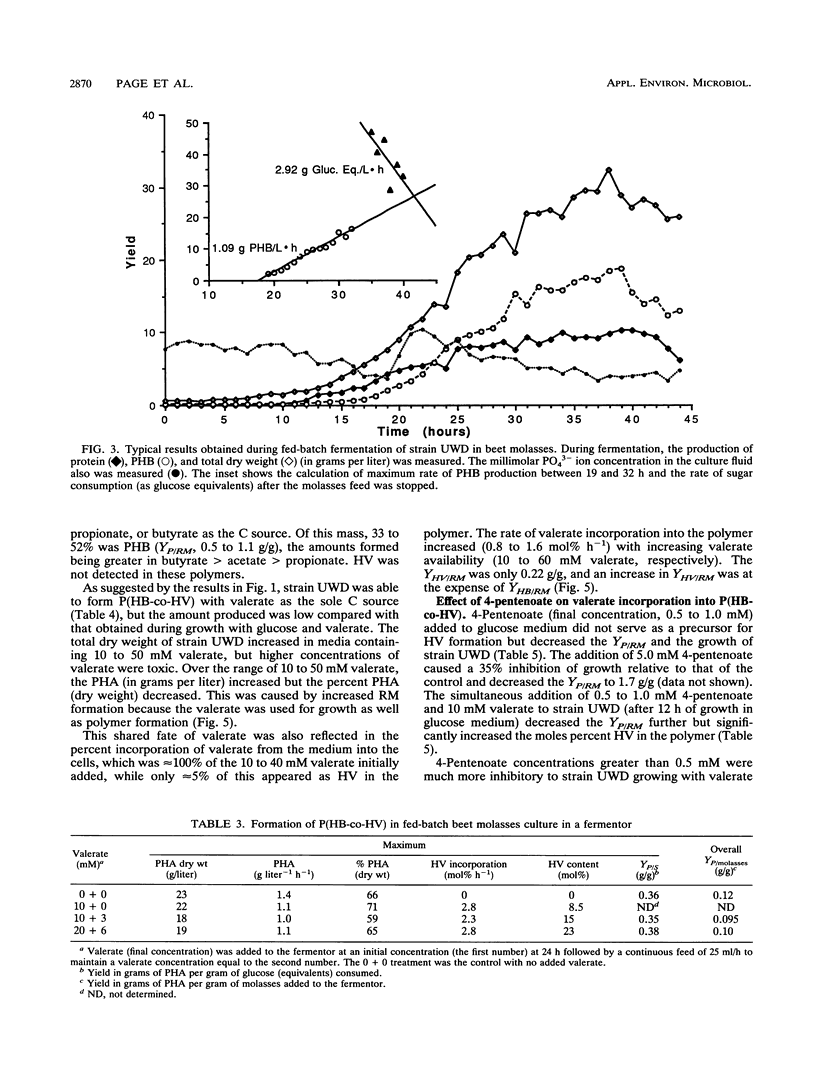Abstract
Azotobacter vinelandii UWD formed polyhydroxyalkanoate (PHA) copolymers containing beta-hydroxybutyrate and beta-hydroxyvalerate (HV) when grown in a medium containing glucose as the primary C source and valerate (pentanoate) as a precursor. Copolymer was not formed when propionate was added to the glucose medium but was formed when heptanoate, nonanoate, or trans-2-pentenoate was present. Optimal levels of HV were formed when valerate was added at the time of maximum PHA synthesis, although HV incorporation was not dependent on glucose catabolism. HV content in the polymer was increased from 17 to 24 mol% by adding 10 to 40 mM valerate to glucose medium, but HV insertion into the polymer occurred at a fixed rate. Similarly, the addition of valerate to a fed-batch culture of strain UWD in beet molasses in a fermentor produced 19 to 22 g of polymer per liter, containing 8.5 to 23 mol% HV after 38 to 40 h. The synthesis of HV in these cultures also occurred at a fixed rate (2.3 to 2.8 mol% h-1), while the maximum PHA production rate was 1.1 g liter-1 h-1. During synthesis of copolymer in batch or fed-batch culture, the yield from conversion of glucose into PHA (YP/S) remained at maximum theoretical efficiency (greater than or equal to 0.33 g of PHA per g of glucose consumed). Up to 45 mol% C source, but the PHA produced amounted to less than 1 g/liter. The combination of 30 mM valerate as a sole C source and 0.5 mM 4-pentenoate increased the HV content in the polymer to 52 mol%.(ABSTRACT TRUNCATED AT 250 WORDS)
Full text
PDF







Selected References
These references are in PubMed. This may not be the complete list of references from this article.
- Anderson A. J., Dawes E. A. Occurrence, metabolism, metabolic role, and industrial uses of bacterial polyhydroxyalkanoates. Microbiol Rev. 1990 Dec;54(4):450–472. doi: 10.1128/mr.54.4.450-472.1990. [DOI] [PMC free article] [PubMed] [Google Scholar]
- Billington D., Osmundsen H., Sherratt H. S. Mechanisms of the metabolic disturbances caused by hypoglycin and by pent-4-enoic acid. In vitro studies. Biochem Pharmacol. 1978;27(24):2879–2890. doi: 10.1016/0006-2952(78)90204-6. [DOI] [PubMed] [Google Scholar]
- Brandl H., Gross R. A., Lenz R. W., Fuller R. C. Pseudomonas oleovorans as a Source of Poly(beta-Hydroxyalkanoates) for Potential Applications as Biodegradable Polyesters. Appl Environ Microbiol. 1988 Aug;54(8):1977–1982. doi: 10.1128/aem.54.8.1977-1982.1988. [DOI] [PMC free article] [PubMed] [Google Scholar]
- Chen G. Q., König K. H., Lafferty R. M. Production of poly-D(-)-3-hydroxybutyrate and poly-D(-)-3-hydroxyvalerate by strains of Alcaligenes latus. Antonie Van Leeuwenhoek. 1991 Jul;60(1):61–66. doi: 10.1007/BF00580443. [DOI] [PubMed] [Google Scholar]
- Dawes E. A., Senior P. J. The role and regulation of energy reserve polymers in micro-organisms. Adv Microb Physiol. 1973;10:135–266. doi: 10.1016/s0065-2911(08)60088-0. [DOI] [PubMed] [Google Scholar]
- George S. E., Costenbader C. J., Melton T. Diauxic growth in Azotobacter vinelandii. J Bacteriol. 1985 Nov;164(2):866–871. doi: 10.1128/jb.164.2.866-871.1985. [DOI] [PMC free article] [PubMed] [Google Scholar]
- Jackson F. A., Dawes E. A. Regulation of the tricarboxylic acid cycle and poly-beta-hydroxybutyrate metabolism in Azotobacter beijerinckii grown under nitrogen or oxygen limitation. J Gen Microbiol. 1976 Dec;97(2):303–312. doi: 10.1099/00221287-97-2-303. [DOI] [PubMed] [Google Scholar]
- LAW J. H., SLEPECKY R. A. Assay of poly-beta-hydroxybutyric acid. J Bacteriol. 1961 Jul;82:33–36. doi: 10.1128/jb.82.1.33-36.1961. [DOI] [PMC free article] [PubMed] [Google Scholar]
- Oeding V., Schlegel H. G. Beta-ketothiolase from Hydrogenomonas eutropha H16 and its significance in the regulation of poly-beta-hydroxybutyrate metabolism. Biochem J. 1973 May;134(1):239–248. doi: 10.1042/bj1340239. [DOI] [PMC free article] [PubMed] [Google Scholar]
- Page W. J., Knosp O. Hyperproduction of Poly-beta-Hydroxybutyrate during Exponential Growth of Azotobacter vinelandii UWD. Appl Environ Microbiol. 1989 Jun;55(6):1334–1339. doi: 10.1128/aem.55.6.1334-1339.1989. [DOI] [PMC free article] [PubMed] [Google Scholar]
- Pawar S., Schulz H. The structure of the multienzyme complex of fatty acid oxidation from Escherichia coli. J Biol Chem. 1981 Apr 25;256(8):3894–3899. [PubMed] [Google Scholar]
- Ramsay B. A., Lomaliza K., Chavarie C., Dubé B., Bataille P., Ramsay J. A. Production of poly-(beta-hydroxybutyric-co-beta-hydroxyvaleric) acids. Appl Environ Microbiol. 1990 Jul;56(7):2093–2098. doi: 10.1128/aem.56.7.2093-2098.1990. [DOI] [PMC free article] [PubMed] [Google Scholar]
- Ritchie G. A., Senior P. J., Dawes E. A. The purification and characterization of acetoacetyl-coenzyme A reductase from Azotobacter beijerinckii. Biochem J. 1971 Jan;121(2):309–316. doi: 10.1042/bj1210309. [DOI] [PMC free article] [PubMed] [Google Scholar]
- Salanitro J. P., Wegener W. S. Growth of Escherichia coli on short-chain fatty acids: growth characteristics of mutants. J Bacteriol. 1971 Nov;108(2):885–892. doi: 10.1128/jb.108.2.885-892.1971. [DOI] [PMC free article] [PubMed] [Google Scholar]
- Salanitro J. P., Wegener W. S. Growth of Escherichia coli on short-chain fatty acids: nature of the uptake system. J Bacteriol. 1971 Nov;108(2):893–901. doi: 10.1128/jb.108.2.893-901.1971. [DOI] [PMC free article] [PubMed] [Google Scholar]
- Schulz H. Metabolism of 4-pentenoic acid and inhibition of thiolase by metabolites of 4-pentenoic acid. Biochemistry. 1983 Apr 12;22(8):1827–1832. doi: 10.1021/bi00277a013. [DOI] [PubMed] [Google Scholar]
- Senior P. J., Dawes E. A. The regulation of poly-beta-hydroxybutyrate metabolism in Azotobacter beijerinckii. Biochem J. 1973 May;134(1):225–238. doi: 10.1042/bj1340225. [DOI] [PMC free article] [PubMed] [Google Scholar]
- Steinbüchel A., Schlegel H. G. Physiology and molecular genetics of poly(beta-hydroxy-alkanoic acid) synthesis in Alcaligenes eutrophus. Mol Microbiol. 1991 Mar;5(3):535–542. doi: 10.1111/j.1365-2958.1991.tb00725.x. [DOI] [PubMed] [Google Scholar]
- Wegener W. S., Reeves H. C., Ajl S. J. Propionate metabolism. II. Factors regulating adaptation of Escherichia coli to propionate. Arch Biochem Biophys. 1968 Jan;123(1):55–61. doi: 10.1016/0003-9861(68)90102-1. [DOI] [PubMed] [Google Scholar]


